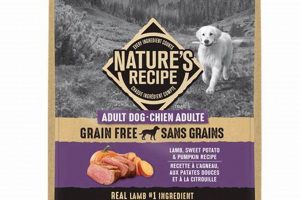This dietary option for canines centers around the stomach lining of ruminant animals, often cattle, sheep, or goats. It can be included in a canine’s diet in fresh, dried, or canned forms. The product is characteristically green or off-white, depending on processing and source.
Providing this particular food source to dogs can offer a range of nutritional advantages. It is generally rich in protein, enzymes, and probiotics, which are considered beneficial for digestive health and overall well-being. Historically, it reflects a more natural and ancestral feeding practice, mirroring the diets of wild canids.
The subsequent discussion will delve into the specific nutritional composition of this food choice, examine the potential health benefits, and provide guidance on safe and effective incorporation into a dog’s diet.
Guidance on Incorporating Tripe in Canine Diets
The following provides essential considerations for introducing and utilizing this specialized food source as part of a canine nutritional plan.
Tip 1: Source Quality Matters: Prioritize suppliers known for high-quality sourcing and processing practices. Verify the origin and handling procedures to minimize potential contamination or degradation of nutritional value.
Tip 2: Gradual Introduction Is Recommended: Introduce it slowly into the diet, starting with small portions, to monitor digestive tolerance and prevent gastrointestinal upset. Over a week or two, progressively increase the quantity while observing stool consistency.
Tip 3: Consider the Form: Fresh, frozen, dried, and canned options each present unique benefits and challenges. Fresh and frozen often retain more nutrients but require proper storage. Dried forms are shelf-stable, and canned varieties offer convenience.
Tip 4: Balance the Diet: While nutritious, it is not a complete and balanced diet on its own. Ensure it is supplemented with other food sources or a complete commercial dog food to meet all nutritional requirements. Consult with a veterinary nutritionist for personalized guidance.
Tip 5: Observe for Allergies or Sensitivities: Some dogs may exhibit sensitivities or allergies to specific animal proteins. Monitor for signs such as itching, skin irritation, or digestive issues, and discontinue use if these symptoms arise.
Tip 6: Handle with Care: Due to its raw nature, follow strict hygiene protocols when handling fresh or frozen varieties. Thoroughly wash hands and surfaces to prevent the spread of bacteria, especially when preparing meals for human consumption as well.
Tip 7: Storage is Crucial: Proper storage is essential to prevent spoilage and maintain nutritional integrity. Fresh and frozen types require airtight containers and freezing temperatures. Dried forms should be stored in a cool, dry place.
Implementing these measures contributes to safe and effective integration into a canines nutritional regimen, potentially enhancing digestive health and overall vitality.
The subsequent section will cover the potential risks associated with its use and offer guidelines for minimizing those risks.
1. Nutritional Composition
The nutritional profile of tripe exerts a significant influence on its suitability and benefits as a dietary component for canines. Understanding its composition is critical for informed decisions regarding its inclusion in a dog’s diet.
- Protein Content
Tripe is a substantial source of protein, essential for muscle development, tissue repair, and various physiological functions in dogs. Its amino acid profile contributes to overall health and supports the immune system. However, protein levels can vary depending on the animal source and processing methods.
- Enzyme and Probiotic Presence
Raw tripe contains naturally occurring digestive enzymes that can aid in food breakdown and nutrient absorption. It also harbors probiotics, beneficial bacteria that contribute to a healthy gut microbiome, supporting digestion and immune function. These components are often diminished or eliminated through cooking or excessive processing.
- Fat Composition
The fat content and type in tripe are significant considerations. It provides essential fatty acids, including omega-3 and omega-6, which are vital for skin and coat health, brain function, and inflammation regulation. However, the fat content can be relatively high, necessitating moderation in the diet, particularly for dogs prone to weight gain or pancreatitis.
- Vitamin and Mineral Profile
It contains various vitamins and minerals, including B vitamins, which play roles in energy metabolism, and minerals such as phosphorus and calcium, important for bone health. However, the levels of these micronutrients may not be sufficient to meet all of a dog’s requirements, necessitating supplementation or a balanced diet.
These facets of its nutritional composition underscore the importance of careful consideration when incorporating it into a canine’s diet. The balance of protein, fat, enzymes, probiotics, vitamins, and minerals must align with the dog’s individual needs and overall dietary plan to maximize benefits and minimize potential risks. Consulting with a veterinary nutritionist is recommended to ensure appropriate integration.
2. Digestive Benefits
The purported digestive benefits of tripe as a canine food source stem from its unique composition. Undigested or partially digested matter within the tripe, along with naturally occurring enzymes, aids the canine digestive process. The presence of probiotics fosters a healthy gut microbiome, which can improve nutrient absorption and overall gastrointestinal health. For example, canines with sensitive stomachs or inflammatory bowel disease may experience reduced symptoms and improved digestion when properly introduced to a diet that includes this ingredient. It’s not intended to be an instant cure.
The digestive benefits relate to several aspects of canine health. Improved nutrient absorption directly supports energy levels, immune function, and coat condition. A balanced gut microbiome can influence mood and behavior. The enzymatic action in raw tripe can alleviate the burden on the pancreas, potentially benefiting dogs with pancreatic insufficiency. However, overfeeding can result in loose stools or digestive upset, negating potential advantages. It is important to remember this food needs to be part of a whole.
In summary, the digestive benefits constitute a key element of the value proposition for tripe in canine diets. The presence of enzymes, probiotics, and partially digested matter are believed to ease digestive processes. While it may offer relief for some dogs with specific digestive issues, responsible and informed usage, guided by veterinary advice, remains vital to maximize its advantages and minimize potential risks. Further research to confirm the clinical efficacy is needed.
3. Sourcing & Processing
The origin and treatment of animal stomach lining significantly affect the quality and safety of this product as a canine food source. The sourcing practices directly influence the nutritional content and potential contamination risks. For instance, cattle raised on grass-fed farms may yield a product with a different fatty acid profile compared to those raised on grain-based diets. Furthermore, the methods employed during processing, such as washing, grinding, and preservation, can impact enzyme activity and probiotic viability.
Proper processing mitigates inherent risks associated with raw animal products. Thorough cleaning reduces the presence of harmful bacteria, such as Salmonella and E. coli. The use of appropriate preservation techniques, such as freezing or freeze-drying, can maintain nutrient integrity and extend shelf life without introducing excessive additives. Conversely, inadequate processing can lead to spoilage, bacterial overgrowth, and reduced nutritional value, rendering the food unsafe or ineffective. Several recalls of pet food products due to bacterial contamination underscore the importance of rigorous quality control during processing.
In summation, the sourcing and processing methods represent critical determinants of the quality, safety, and nutritional value of this particular product. Opting for suppliers with transparent and stringent quality control measures, coupled with appropriate handling and storage practices, is vital to mitigate potential risks and ensure that canines derive the intended benefits. Neglecting these aspects can compromise animal health and well-being. The traceability of product from farm to canine bowl has become more critical.
4. Proper Introduction
The integration of tripe into a canine diet necessitates a gradual and monitored introduction process. This is predicated on the composition of tripe, which is rich in nutrients and enzymes, and on the potential for gastrointestinal upset in dogs unaccustomed to such a diet. Introducing the food too rapidly can overwhelm the digestive system, leading to diarrhea, vomiting, or loss of appetite. This adverse reaction can negate the potential benefits of the product and may create an aversion to it. For example, a dog previously fed a kibble-only diet might experience digestive distress if suddenly switched to a diet with a large proportion of this food. Gradual implementation allows the digestive system to adapt.
The proper introduction of tripe commonly involves mixing small quantities with the dog’s existing food over a period of several days to weeks. This allows the gut microbiome to adjust and facilitates enzyme production necessary for efficient digestion. The initial amount of this food might be as low as 10% of the total meal, gradually increasing to 50% or more, depending on the individual dog’s tolerance and response. Monitoring stool consistency and overall appetite during this period is critical to assess the dog’s adaptation to the new dietary element. Should digestive issues arise, reducing the amount or temporarily discontinuing use is advisable.
In conclusion, responsible inclusion into a canine diet depends on a measured and observant introduction. This minimizes the risk of adverse reactions and maximizes the opportunity for dogs to reap its nutritional benefits. Neglecting this aspect can compromise the digestive health of the animal and undermine the intended advantages of this food source. The observed response guides the pace and extent of its adoption into the diet, ensuring compatibility with the animal’s physiology.
5. Dietary Balance
The incorporation of tripe into a canine diet necessitates a careful consideration of dietary balance. Tripe, while nutrient-rich, is not a complete and balanced food source on its own. Its high protein and fat content, coupled with the presence of enzymes and probiotics, can be beneficial, but it often lacks sufficient quantities of essential vitamins, minerals, and carbohydrates to meet all of a dog’s nutritional requirements. Therefore, relying solely on this product can lead to nutritional deficiencies and associated health problems. For example, a diet consisting only of tripe may result in calcium deficiencies over time, leading to bone weakness or other skeletal issues.
To achieve dietary balance when including tripe, it should be integrated as part of a varied diet. This commonly involves combining it with commercial dog food formulations, other protein sources, vegetables, and supplemental vitamins and minerals. The proportions of these components should be tailored to the individual dog’s age, breed, activity level, and health status. A working dog with high energy demands, for instance, may require a higher percentage of protein and fat, whereas a senior dog with reduced activity may need a lower-calorie diet with added fiber. Consultation with a veterinary nutritionist can provide personalized guidance to ensure that all nutritional needs are met. The risks and benefits are to be considered, because this product can have drawbacks too.
In summary, achieving dietary balance is an essential aspect of using tripe in canine nutrition. This entails recognizing the inherent limitations of this food as a sole dietary component and integrating it strategically within a broader feeding plan that addresses all nutritional requirements. Neglecting this principle can compromise the health and well-being of the animal, highlighting the importance of informed decision-making and expert guidance. This will help to avoid nutrition problems and promote pet health.
6. Potential Risks
The integration of animal stomach lining into a canine diet, while potentially beneficial, involves inherent risks that must be carefully considered. These risks stem from the nature of raw animal products and the potential for contamination or improper handling, which can compromise animal health.
- Bacterial Contamination
Raw animal products may harbor harmful bacteria, such as Salmonella, E. coli, and Campylobacter. These pathogens can cause gastrointestinal illness in dogs, characterized by vomiting, diarrhea, and fever. Improper handling and storage of this food can exacerbate bacterial growth, increasing the risk of infection. Thorough washing and proper refrigeration are essential preventative measures.
- Parasitic Infestation
Raw animal tissues may contain parasites, including worms and protozoa, that can infect dogs upon consumption. These parasites can cause a range of health problems, from mild digestive upset to severe organ damage. Freezing this food at sufficiently low temperatures for an extended period can kill many parasites, but not all. Veterinary examination and fecal testing are advisable to detect and treat any parasitic infections.
- Nutritional Imbalance
Sole reliance on this food can lead to nutritional imbalances if not properly supplemented. While it is rich in protein and fat, it may lack essential vitamins, minerals, and trace elements. Deficiencies in these nutrients can result in various health problems, including bone abnormalities, skin disorders, and immune dysfunction. A balanced diet, formulated with the guidance of a veterinary nutritionist, is crucial to prevent nutritional deficiencies.
- Spoilage and Rancidity
The high fat content of this food makes it susceptible to spoilage and rancidity, particularly if not stored properly. Rancid fats can produce harmful compounds that can cause gastrointestinal upset and potentially contribute to long-term health problems. Proper storage in airtight containers at low temperatures can slow down the process of spoilage. Discarding any product that exhibits an off odor or discoloration is essential.
These risks underscore the importance of responsible handling, proper storage, and careful integration into a balanced diet. While the potential benefits of this food are often touted, the associated risks cannot be ignored. Mitigating these risks through informed practices and veterinary consultation is paramount to ensuring the health and well-being of canines consuming this food source.
Frequently Asked Questions
The following addresses common inquiries regarding this specific dietary option for canines, providing clarification on its use and related considerations.
Question 1: Is all tripe the same, regardless of animal source?
No, the nutritional composition of tripe can vary depending on the animal from which it originates. For example, tripe from grass-fed cattle may have a different fatty acid profile than tripe from grain-fed cattle. Similarly, tripe from sheep or goats may possess slightly different nutrient ratios. This variation can influence the suitability of a specific type for individual dogs with particular dietary needs.
Question 2: Can tripe completely replace commercial dog food?
Tripe should not be used as a sole replacement for commercial dog food. While it provides valuable protein, enzymes, and probiotics, it may lack essential vitamins, minerals, and carbohydrates necessary for a complete and balanced canine diet. It is best used as a supplement to a well-formulated commercial diet or as part of a carefully planned homemade diet formulated by a veterinary nutritionist.
Question 3: What are the signs of an allergic reaction?
Signs of an allergic reaction to tripe can include itching, skin rashes, hives, facial swelling, vomiting, diarrhea, and respiratory distress. If a dog exhibits any of these symptoms after consuming this food, discontinue its use immediately and consult a veterinarian.
Question 4: How should it be stored?
Storage protocols depend on the form. Fresh tripe should be refrigerated and used within a few days or frozen for longer storage. Dried tripe should be stored in a cool, dry place in an airtight container. Canned tripe should be refrigerated after opening and used within the timeframe specified on the label.
Question 5: Is green tripe better than bleached tripe?
Green tripe, which is unbleached and uncleaned, is generally considered more nutritious than bleached tripe. Bleaching removes many of the beneficial enzymes and probiotics, reducing its nutritional value. Green tripe retains more of its natural nutrients and digestive enzymes, making it a more desirable option for canines.
Question 6: Can puppies consume it?
Puppies can consume it, but it should be introduced gradually and in small amounts as part of a balanced diet. Puppies have sensitive digestive systems, and introducing new foods too quickly can cause gastrointestinal upset. Consult a veterinarian before introducing it to a puppy’s diet to ensure that it is appropriate for their age and developmental stage.
Incorporating this component requires understanding its nutritional profile, potential risks, and proper handling techniques. Consulting with a veterinarian or veterinary nutritionist is recommended to tailor its use to an individual dog’s needs.
The subsequent section will delve into the economic and environmental considerations associated with the production and consumption of this food source.
Conclusion
The preceding exploration of tripe dog food has illuminated several critical aspects of its role in canine nutrition. The analysis has covered nutritional composition, digestive benefits, sourcing and processing considerations, proper introduction methods, the importance of dietary balance, and the potential risks associated with its use. Understanding these facets is essential for making informed decisions regarding its inclusion in a canine’s diet.
The future of tripe dog food as a canine dietary component hinges on continued research into its long-term health effects, refinement of processing techniques to minimize risks, and greater transparency in sourcing practices. Veterinary professionals and canine caregivers alike must remain vigilant in evaluating the suitability of this food source for individual animals and prioritizing their health and well-being above all else. Only through diligent attention to these considerations can the potential benefits be realized while mitigating the inherent risks.







![Best Dog Food: Castor & Pollux [Review + Guide] World’s Most Delicious Foods: Must-Try Dishes from Every Country Best Dog Food: Castor & Pollux [Review + Guide] | World’s Most Delicious Foods: Must-Try Dishes from Every Country](https://lisasfoods.com/wp-content/uploads/2025/11/th-645-300x200.jpg)